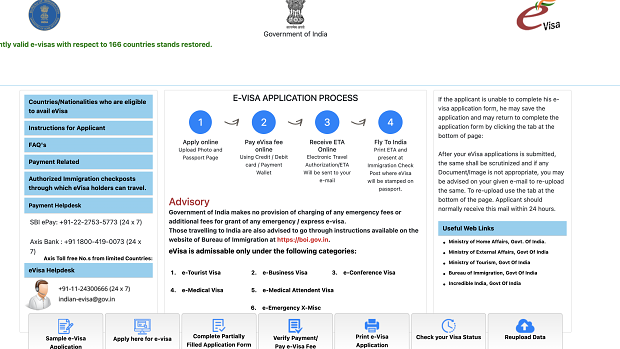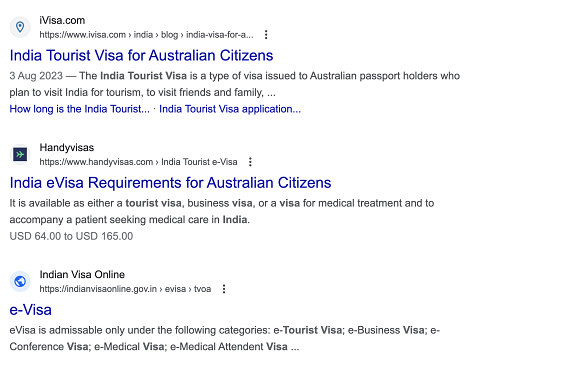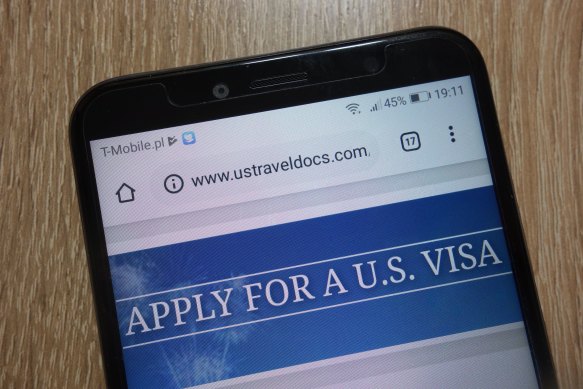This was published 1 year ago
Even the most experienced travellers are falling for these online visa scams
The visa scammers
I need an eVisa for India. When I search on Google, I’m offered a choice of websites to lodge my application, including India eVisa (indiaevisas.info), iVisa (ivisa.com), Indian Visa Online (traveldocs-india.com), Indian Travel Consultant (indianonlinetravel.org), E-Visa India (indiatravel-services.com), Handy Visas (handyvisas.com) and Indian Visa Online (indianvisaonline.gov.in/evisa). Except for the last one, they’re all unofficial sites that will deliver my e-Visa, but they’ll add a hefty fee to the $US25 ($A39) that the Indian Government charges.

The official visa application website for India.Credit: Screenshot
Back in the pre-digital era, obtaining a visa was tedious. You went along to an embassy, high commission or consulate, filled in a form, attached one or two passport photos along with your passport and a week or two later you were summoned to collect it. Over the past couple of decades most governments have begun offering electronic travel authorisations (ETAs) or e-visas, available via an online application. ETAs are quicker to process, cheaper to administer and more convenient for the applicant, but in doing so they have created a business opportunity for scammers.
It’s not hard to knock up a website with a country’s flag and a few iconic images to masquerade as an official visa application portal. While the operators of those websites will walk you through the process and submit your visa application to the relevant authorities, they whack on a hefty administration fee. It’s a trap for the unwary, and many seasoned travellers get caught. In 2018, instead of the official $US14 ($A21.70) fee for a US ESTA, I went through the application process and was close to paying $US95 ($A147.40) before the alarm bells rang.

A Google search will return a choice of unofficial websites to lodge a visa application.
Although some of these commercial sites offer expedited processing for a higher fee, in general there is nothing they do to speed up the visa application process. Since it adds another layer to the visa request, it’s slower than applying through official channels. A commercial site might wait for your credit card payment to appear in their account before forwarding your application. Once past the paywall, you’ve given all your credit card details to an agency set up to fleece you. Who’s to say what they might do with that information?
Opportunity knocks during the pandemic
During the pandemic many countries instituted protocols requiring travellers to complete an online health declaration with proof of vaccination against COVID-19 as a condition of entry. Although most countries have wound back that requirement, a few such as Singapore still require it, creating another opportunity for the scammers.
All visitors to the island state must submit a Singapore Arrival Card (SGAC), either an electronic version or a paper one, available at the immigration counters upon arrival at Singapore’s Changi Airport and other border posts. It’s a lot more convenient and quicker to complete the electronic version at the Immigration Checkpoints Authority’s (ICA) website (ica.gov.sg), and it’s free, but not if you fall for the official-looking iVisa website (ivisa.com). If you do you’ll pay $US48.99 ($A77.60). Need it right now? That’ll cost you $US150.99 ($A234), promised delivery within 30 minutes. Or you might do it at the official looking Singapore Visa Online website (singaporevisaonline.sg), in which case you’ll pay $US26.20 ($A40.65). Ironically, iVisa has a page titled “Travel Visa Scams: How to Avoid and Detect Them”.
The visa waiver that costs more than it should

Avoid using commercial websites when applying for a visa waiver for the US.Credit: Alamy
Rather than a visa, many countries now allow Australian passport holders to enter with a visa waiver. Obtaining the visa waiver is another online process, creating one more fruitful source of income for the middlemen. Australians are among multiple nationalities that are entitled to apply for an Electronic System for Travel Authorisation (ESTA) before travelling to the USA under the country’s Visa Waiver Program. Google “apply for US visa waiver” and the first website that appears is GovAssist (visa.govassist.com). Fill in their application form and you’ll pay $US89 ($A138). The second entry on that Google search page is the official US Customs and Border Protection website (esta.cbp.dhs.gov), where your ESTA application will cost $US21 ($A32.60). Out of the 12 websites listed on the first Google search page, four are commercial sites.
The European Travel Information and Authorisation System (ETIAS), a visa-waiver system similar to the US’s ESTA, will soon come into effect in Europe’s Schengen Zone. Australian passport holders intending to visit Schengen Zone countries are eligible to apply at the official website. The application fee is €7, but expect the opportunists to pile in.
Governments don’t like it but there’s not much they can do to stop it. According to the Singapore Government’s ICA website. “ICA does not support or endorse services offered by commercial entities who provide assistance in submitting the SG Arrival Card at a fee.” But Google does. Google makes money from pushing scam sites to the top of the placement ladder, elevating them above the official e-visa websites on their search response page. In its defence, Google maintains it’s just the medium, it’s not responsible for the message.
Finding the real deal
Type your visa request into your favourite search engine and the official government websites will usually have “gov” somewhere in their URL. Alternatively, the country’s flag might appear beside the URL on the search page.
Some official ETA websites
Cambodia
correction
An earlier version of this story had an incorrect URL for the ETIAS website.
Sign up for the Traveller newsletter
The latest travel news, tips and inspiration delivered to your inbox. Sign up now.